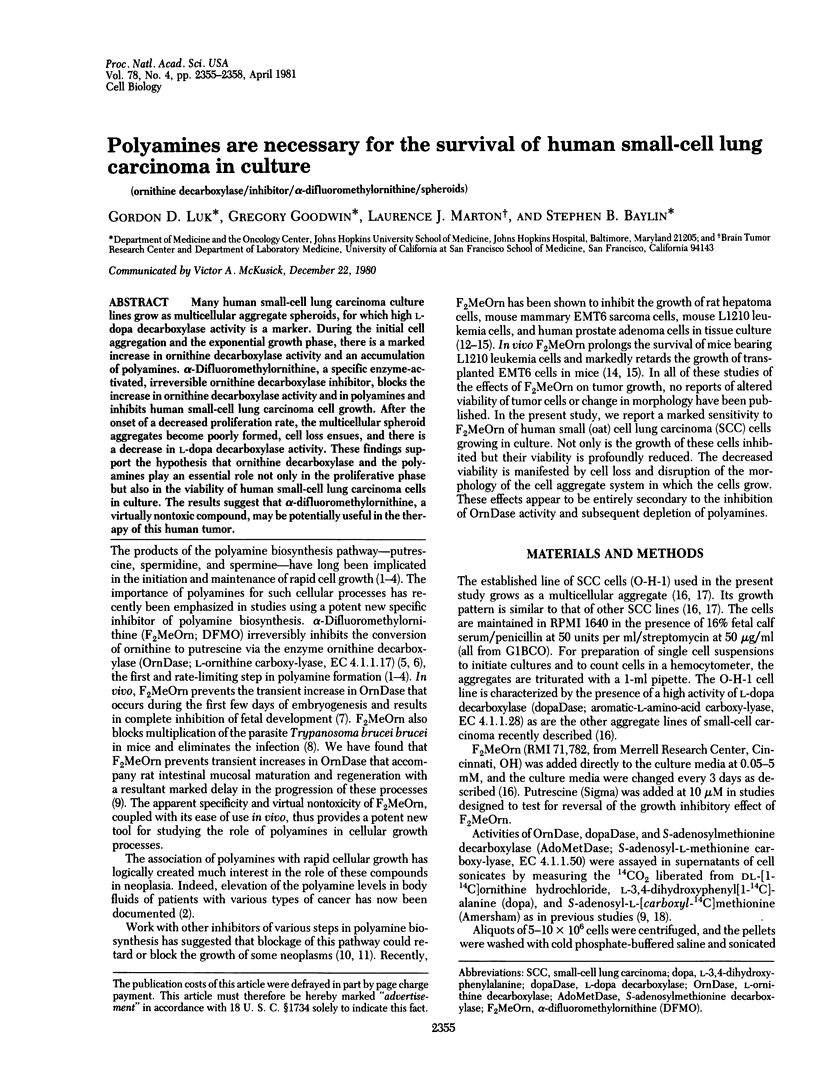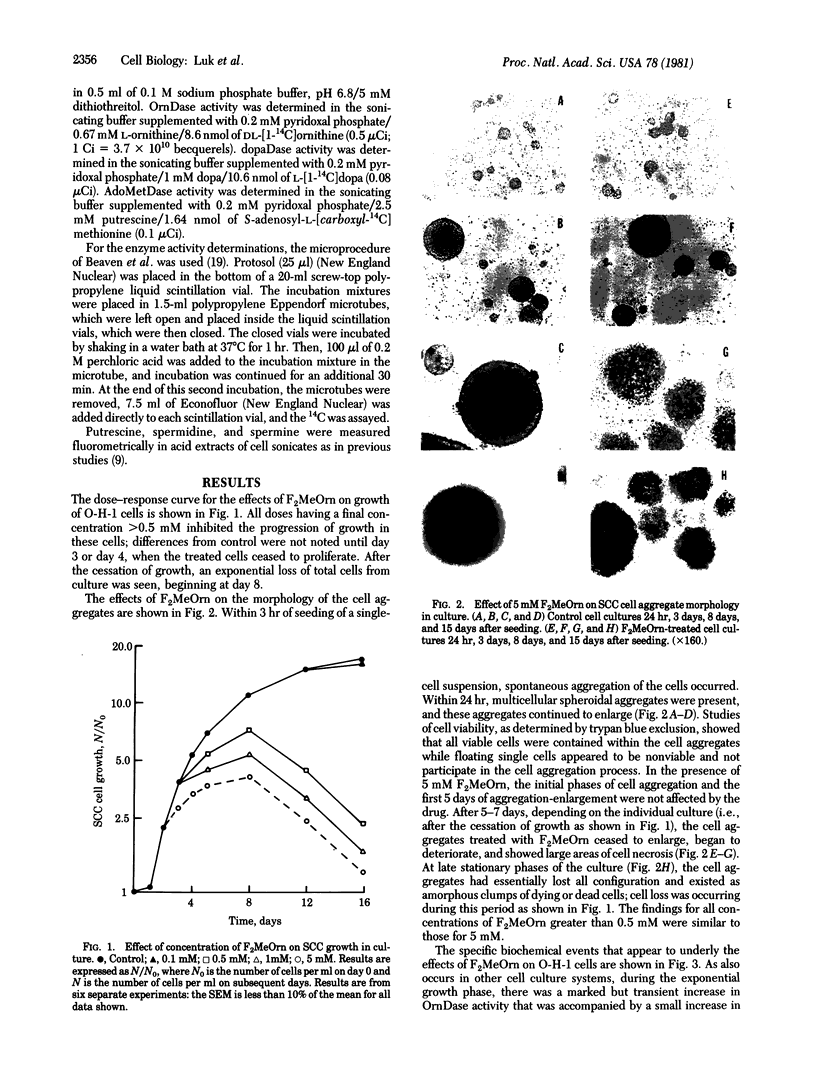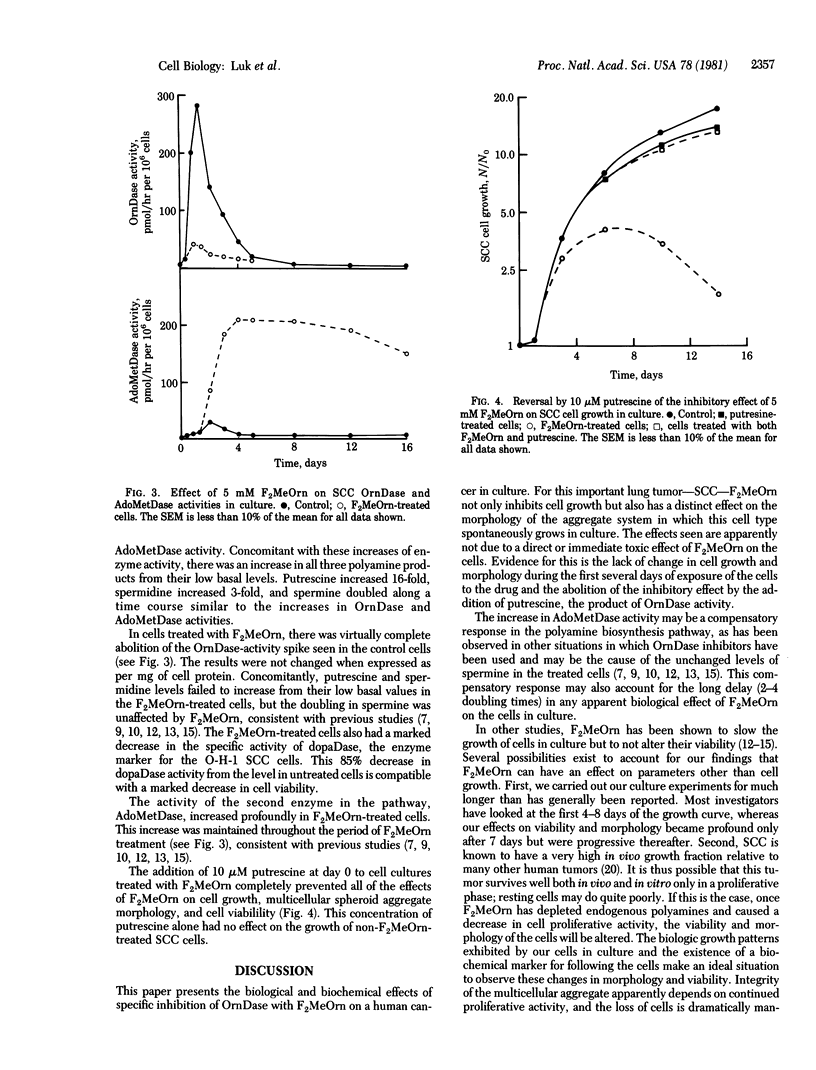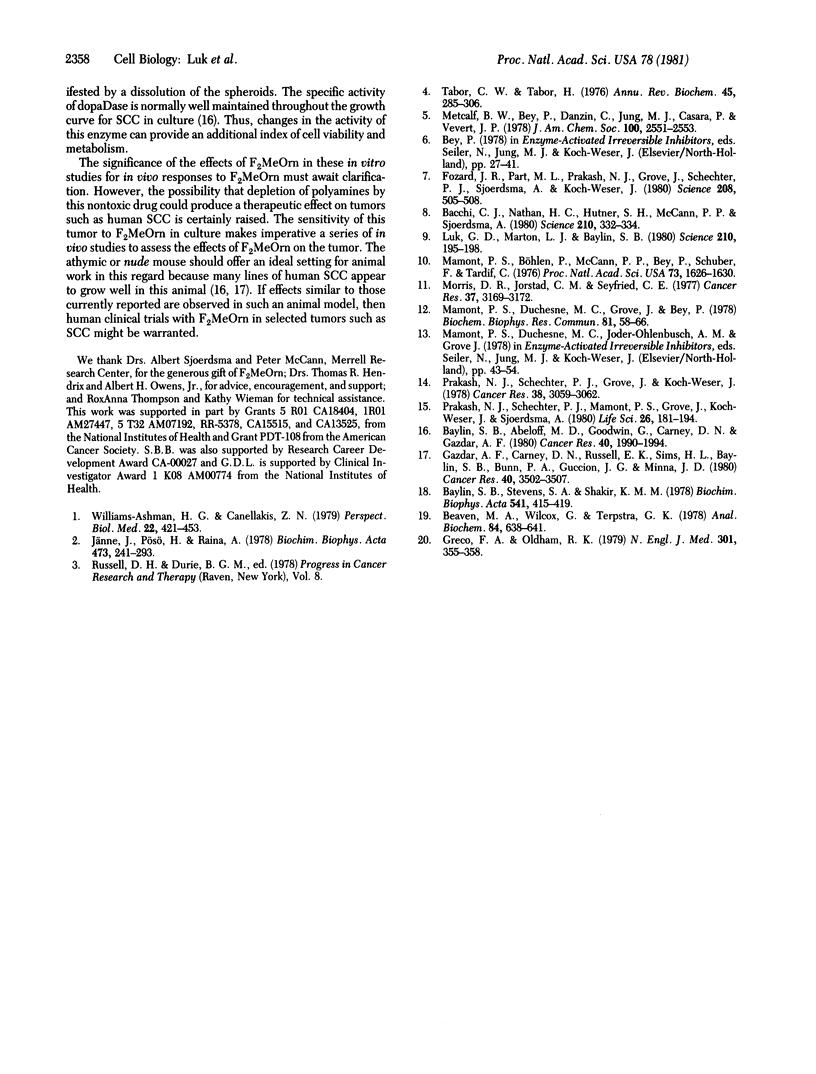Abstract
Many human small-cell lung carcinoma culture lines grow as multicellular aggregate spheroids, for which high L-dopa decarboxylase activity is a marker. During the initial cell aggregation and the exponential growth phase, there is a marked increase in ornithine decarboxylase activity and an accumulation of polyamines. alpha-Difluoromethylornithine, a specific enzyme-activated, irreversible ornithine decarboxylase inhibitor, blocks the increase in ornithine decarboxylase activity and in polyamines and inhibits human small-cell lung carcinoma cell growth. After the onset of a decreased proliferation rate, the multicellular spheroid aggregates become poorly formed, cell loss ensues, and there is a decrease in L-dopa decarboxylase activity. These findings support the hypothesis that ornithine decarboxylase and the polyamines play an essential role not only in the proliferative phase but also in the viability of human small-cell lung carcinoma cells in culture. The results suggest that alpha-difluoromethylornithine, a virtually nontoxic compound, may be potentially useful in the therapy of this human tumor.
Full text
PDF



Images in this article
Selected References
These references are in PubMed. This may not be the complete list of references from this article.
- Bacchi C. J., Nathan H. C., Hutner S. H., McCann P. P., Sjoerdsma A. Polyamine metabolism: a potential therapeutic target in trypanosomes. Science. 1980 Oct 17;210(4467):332–334. doi: 10.1126/science.6775372. [DOI] [PubMed] [Google Scholar]
- Baylin S. B., Abeloff M. D., Goodwin G., Carney D. N., Gazdar A. F. Activities of L-dopa decarboxylase and diamine oxidase (histaminase) in human lung cancers and decarboxylase as a marker for small (oat) cell cancer in cell culture. Cancer Res. 1980 Jun;40(6):1990–1994. [PubMed] [Google Scholar]
- Baylin S. B., Stevens S. A., Shakir K. M. Association of diamine oxidase and ornithine decarboxylase with maturing cells in rapidly proliferating epithelium. Biochim Biophys Acta. 1978 Jul 3;541(3):415–419. doi: 10.1016/0304-4165(78)90200-3. [DOI] [PubMed] [Google Scholar]
- Beaven M. A., Wilcox G., Terpstra G. K. A microprocedure for the measurement of 14CO2 release from [14C]carboxyl-labeled amino acids. Anal Biochem. 1978 Feb;84(2):638–641. doi: 10.1016/0003-2697(78)90089-1. [DOI] [PubMed] [Google Scholar]
- Fozard J. R., Part M. L., Prakash N. J., Grove J., Schechter P. J., Sjoerdsma A., Koch-Weser J. L-Ornithine decarboxylase:an essential role in early mammalian embryogenesis. Science. 1980 May 2;208(4443):505–508. doi: 10.1126/science.6768132. [DOI] [PubMed] [Google Scholar]
- Gazdar A. F., Carney D. N., Russell E. K., Sims H. L., Baylin S. B., Bunn P. A., Jr, Guccion J. G., Minna J. D. Establishment of continuous, clonable cultures of small-cell carcinoma of lung which have amine precursor uptake and decarboxylation cell properties. Cancer Res. 1980 Oct;40(10):3502–3507. [PubMed] [Google Scholar]
- Greco F. A., Oldham R. K. Current concepts in cancer: small-cell lung cancer. N Engl J Med. 1979 Aug 16;301(7):355–358. doi: 10.1056/NEJM197908163010704. [DOI] [PubMed] [Google Scholar]
- Jänne J., Pösö H., Raina A. Polyamines in rapid growth and cancer. Biochim Biophys Acta. 1978 Apr 6;473(3-4):241–293. doi: 10.1016/0304-419x(78)90015-x. [DOI] [PubMed] [Google Scholar]
- Lux G. D., Marton L. J., Baylin S. B. Ornithine decarboxylase is important in intestinal mucosal maturation and recovery from injury in rats. Science. 1980 Oct 10;210(4466):195–198. doi: 10.1126/science.6774420. [DOI] [PubMed] [Google Scholar]
- Mamont P. S., Böhlen P., McCann P. P., Bey P., Schuber F., Tardif C. Alpha-methyl ornithine, a potent competitive inhibitor of ornithine decarboxylase, blocks proliferation of rat hepatoma cells in culture. Proc Natl Acad Sci U S A. 1976 May;73(5):1626–1630. doi: 10.1073/pnas.73.5.1626. [DOI] [PMC free article] [PubMed] [Google Scholar]
- Mamont P. S., Duchesne M. C., Grove J., Bey P. Anti-proliferative properties of DL-alpha-difluoromethyl ornithine in cultured cells. A consequence of the irreversible inhibition of ornithine decarboxylase. Biochem Biophys Res Commun. 1978 Mar 15;81(1):58–66. doi: 10.1016/0006-291x(78)91630-3. [DOI] [PubMed] [Google Scholar]
- Morris D. R., Jorstad C. M., Seyfried C. E. Inhibition of the synthesis of polyamines and DNA in activated lymphocytes by a combination of alpha-methylornithine and methylglyoxal bis(guanylhydrazone). Cancer Res. 1977 Sep;37(9):3169–3172. [PubMed] [Google Scholar]
- Prakash N. J., Schechter P. J., Grove J., Koch-Weser J. Effect of alpha-difluoromethylornithine, an enzyme-activated irreversible inhibitor of ornithine decarboxylase, on L1210 leukemia in mice. Cancer Res. 1978 Sep;38(9):3059–3062. [PubMed] [Google Scholar]
- Prakash N. J., Schechter P. J., Mamont P. S., Grove J., Koch-Weser J., Sjoerdsma A. Inhibition of EMT6 tumor growth by interference with polyamine biosynthesis; effects of alpha-difluoromethylornithine, an irreversible inhibitor of ornithine decarboxylase. Life Sci. 1980 Jan 21;26(3):181–194. doi: 10.1016/0024-3205(80)90292-1. [DOI] [PubMed] [Google Scholar]
- Tabor C. W., Tabor H. 1,4-Diaminobutane (putrescine), spermidine, and spermine. Annu Rev Biochem. 1976;45:285–306. doi: 10.1146/annurev.bi.45.070176.001441. [DOI] [PubMed] [Google Scholar]
- Williams-Ashman H. G., Canellakis Z. N. Polyamines in mammalian biology and medicine. Perspect Biol Med. 1979 Spring;22(3):421–453. doi: 10.1353/pbm.1979.0013. [DOI] [PubMed] [Google Scholar]










